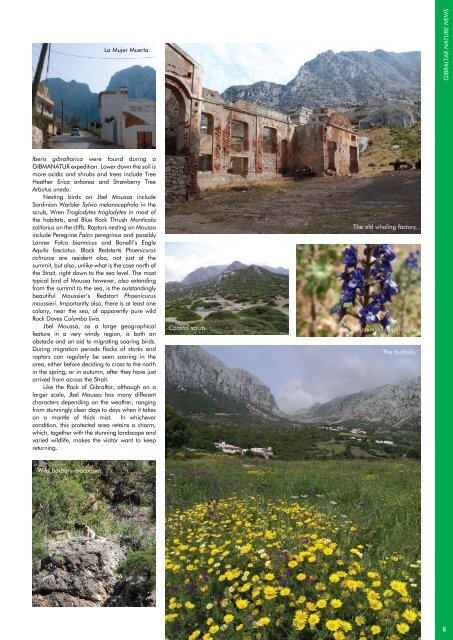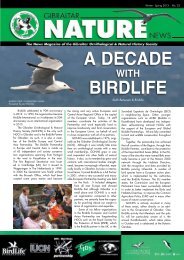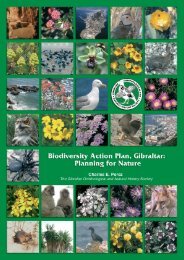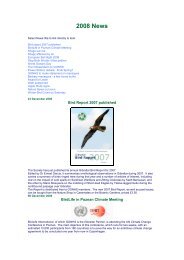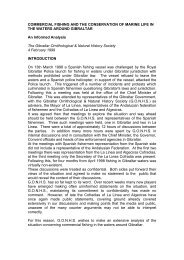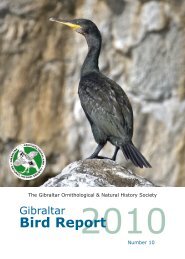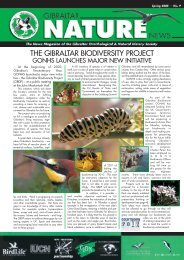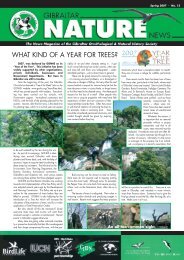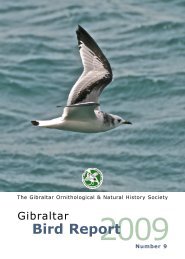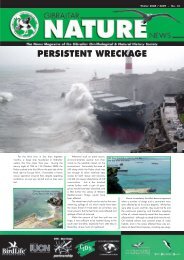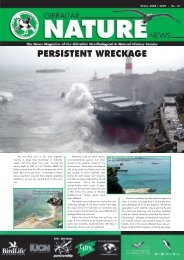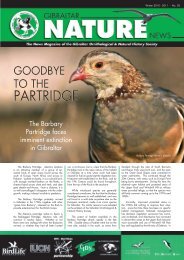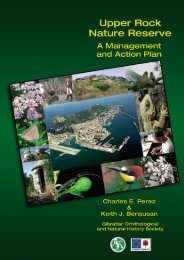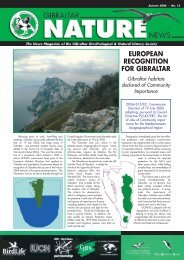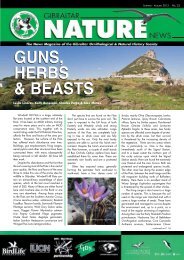No.15 - Gibraltar Ornithological & Natural History Society
No.15 - Gibraltar Ornithological & Natural History Society
No.15 - Gibraltar Ornithological & Natural History Society
Create successful ePaper yourself
Turn your PDF publications into a flip-book with our unique Google optimized e-Paper software.
Iberis gibraltarica were found during a<br />
GIBMANATUR expedition. Lower down the soil is<br />
more acidic and shrubs and trees include Tree<br />
Heather Erica arborea and Strawberry Tree<br />
Arbutus unedo.<br />
Nesting birds on Jbel Moussa include<br />
Sardinian Warbler Sylvia melanocephala in the<br />
scrub, Wren Troglodytes troglodytes in most of<br />
the habitats, and Blue Rock Thrush Monticola<br />
solitarius on the cliffs. Raptors nesting on Moussa<br />
include Peregrine Falco peregrinus and possibly<br />
Lanner Falco biarmicus and Bonelli’s Eagle<br />
Aquila fasciatus. Black Redstarts Phoenicurus<br />
ochruros are resident also, not just at the<br />
summit, but also, unlike what is the case north of<br />
the Strait, right down to the sea level. The most<br />
typical bird of Moussa however, also extending<br />
from the summit to the sea, is the outstandingly<br />
beautiful Moussier’s Redstart Phoenicurus<br />
moussieri. Importantly also, there is at least one<br />
colony, near the sea, of apparently pure wild<br />
Rock Doves Columba livia.<br />
Jbel Moussa, as a large geographical<br />
feature in a very windy region, is both an<br />
obstacle and an aid to migrating soaring birds.<br />
During migration periods flocks of storks and<br />
raptors can regularly be seen soaring in the<br />
area, either before deciding to cross to the north<br />
in the spring, or in autumn, after they have just<br />
arrived from across the Strait.<br />
Like the Rock of <strong>Gibraltar</strong>, although on a<br />
larger scale, Jbel Moussa has many different<br />
characters depending on the weather, ranging<br />
from stunningly clear days to days when it takes<br />
on a mantle of thick mist. In whichever<br />
condition, this protected area retains a charm,<br />
which, together with the stunning landscape and<br />
varied wildlife, makes the visitor want to keep<br />
returning.<br />
Wild barbary macaques.<br />
La Mujer Muerta.<br />
The old whaling factory.<br />
Coastal scrub. Delphinium staphisagria.<br />
The foothills.<br />
GIBRALTAR NATURE NEWS<br />
5


